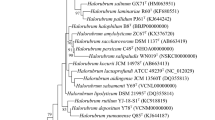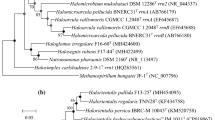Abstract
Recently, heterotrophic nanoflagellates (HNF) have been reported to actively ingest prokaryotes in high salinity waters. We report the isolation and culture of an HNF from a Korean saltern pond of 300‰ salinity. The organism is biflagellated with an acronematic anterior flagellum and never glides on surfaces. The mitochondria have tubular cristae. Neither transitional helix nor spiral fiber were observed in the transition zones of the flagella. The cell has a cytostome supported by an arc of eight microtubules, suggesting that our isolate is a bicosoecid. Our isolate had neither mastigonemes, lorica, body scales, nor cytopharynx and thus could not be placed in any of the presently described bicosoecid genera. Phylogenetic analysis of 18S rRNA gene sequences from stramenopiles confirmed the bicosoecid affinities of our isolate, but did not place it within any established genus or family. Its closest relatives include Caecitellus and Cafeteria. The optimal range of growth temperature was 30–35°C. The isolated HNF grew optimally at 150‰ salinity and tolerated up to 363‰ salinity, but it failed to grow below 75‰ salinity, indicating that it could be a borderline extreme halophile. On the basis of its morphological features and position in 18S rRNA trees we propose a novel genus for our isolate; Halocafeteria, n. gen. The species name Halocafeteria seosinensis sp. nov. is proposed.






Similar content being viewed by others
References
Ausubel FM, Brent R, Kingston RE, Moore DD, Seidman JG, Smith JA, Struhl K (1999) Current protocols in molecular biology. Wiley, New York
Bloem J, Bär-Gilissen M-JB, Cappenberg TE (1986) Fixation, counting, and manipulation of heterotrophic nanoflagellates. Appl Environ Microbiol 52:1266–1272
Brooker BE (1971) Fine structure of Bodo saltans and Bodo candatus (Zoomastigophora, Protozoa) and their affinities with the Tryanosomatidae. Bull Br Mus Nat Hist 22:89–102
Caron DA (1986) Effect of temperature on growth, respiration, and nutrient regeneration by an omnivorous microflagellate. Appl Environ Microbiol 52:1340–1347
Cavalier-Smith T (2000) Flagellate megaevolution: the basis for eukaryote diversification. In: Leadbeater BSC, Green JC (eds) The flagellates. Systematics Association Special Publications, Taylor & Francies, London, pp 361–390
Cavalier-Smith T, Chao EE (2006) Phylogeny and megasystematics of phagotrophic heterokonts (Kingdom Chromista). J Mol Evol 62:388–420
Casamayor EO, Massana R, Benlloch S, Øvreås L, et al (2002) Changes in archaeal, prokaryotes and eukaryal assemblages along a salinity gradient by comparison of genetic fingerprinting methods in a multipond solar saltern. Environ Microbiol 4:338–348
Choi DH, Cho BC (2005) Idiomarina seosinensis sp. nov., isolated from hypersaline water of a solar saltern in Korea. Int J Syst Evol Microbiol 55:379–383
Clavero E, Hernández-Mariné M, Grimalt JO, Garcia-Pichel F (2000) Salinity tolerance of diatoms from thalassic hypersaline environments. J Phycol 36:1021–1034
Díez B, Pedrós-Alió C, Marsh TL, Massana R (2001) Application of denaturing gradient gel elctrophoresis (DGGE) to study the diversity of marine picoeukaryotic assemblages and comparison of DGGE with other molecular techniques. Appl Environ Microbiol 67:2942–2951
Dujardin MF (1841) Histoire naturelle des zoophytes. Infusoires, comprenant la physiologie et la classification de ces animaux, et la maniére de les étudier a l’aide du microscope. Librairie Encyclopédique de Roret, Paris
Felsenstein J (1981) Evolutionary trees from DNA sequences: a maximum likelihood approach. J Mol Evol 17:368–376
Felsenstein J (1985) Confidence limits on phylogenies: an approach using the bootstrap. Evolution 39:783–791
Fenchel T (1986) The ecology of heterotrophic microflagellates. Adv Microb Ecol 9:57–97
Fenchel T, Patterson DJ (1988) Cafeteria roenbergensis nov. gen., nov. sp., a heterotrophic microflagellate from marine plankton. Mar Microb Food Web 3:9–19
Fitch WM (1971) Toward defining the course of evolution: minimum change for a specific tree topology. Syst Zool 20:406–416
Guillou L, Chrétiennot-Dinet M-J, Boulben S, Moon-van der Staay SY, Vaulot D (1999) Symbiomonas scintillans gen. et sp. nov. and Picophagus flagellatus gen. et sp. nov. (Heterokonta): two new heterotrophic flagellates of picoplanktonic size. Protist 150:383–398
Huelsenbeck JP (2000) MrBayes: Bayesian inference of phylogeny. Distributed by the author. Department of Biology, University of Rochester, Rochester
Huelsenbeck JP, Ronquist F (2001) MrBAYES: Bayesian inference of phylogenetic trees. Bioinformatics 17:754–755
Javor B (1989) Hypersaline environments: microbiology and biogeochemistry. Springer, Berlin Heidelberg New York, pp 5–204
Karpov SA (2000) Ultrastructure of the aloricate bicosoecid Pseudobodo tremulans, with revision of the order Bicosoecida. Protistology 1:101–109
Karpov SA, Sogin ML, Silberman JD (2001) Rootlet homology, taxonomy, and phylogeny of bicosoecids based on 18S rRNA gene sequences. Protistology 2:34–47
Kusher DJ (1978) Microbial life in extreme environments. Academic, New York, p 323
Lee WJ, Patterson DJ (2002) Abundance and biomass of heterotrophic flagellates, and factors controlling their abundance and distribution in sediments of Botany Bay. Microb Ecol 43:467–481
Medlin L, Elwood HJ, Stickel S, Sogin ML (1988) The characterization of enzymatically amplified eukaryotic 16S-like rRNA coding regions. Gene 71:491–499
Namyslowski B (1913) Über unbekannte halophile Mikroorganismen aus dem Innern des Salzbergwerkes Wieliczka. Bull Int Acad Sci Krakow B 3/4:88–104
O’Kelly CJ, Nerad TA (1998) Kinetid architecture and bicosoecid affinities of the marine heterotrophic nanoflagellate Caecitellus parvulus (Griessmann 1913) Patterson et al. (1993). Eur J Protistol 34:369–375
Oren A (1995) The role of glycerol in the nutrition of halophilic archaeal communities: a study of respiratory electron transport. FEMS Microbiol Ecol 16:281–290
Oren A (2002) Molecular ecology of extremely halophilic archaea and bacteria. FEMS Microbiol Ecol 39:1–7
Park JS, Kim HJ, Choi DH, Cho BC (2003) Active flagellates grazing on prokaryotes in high salinity waters of a solar saltern. Aquat Microb Ecol 33:173–179
Patterson DJ, Simpson AGB (1996) Heterotrophic flagellates from coastal marine and hypersaline sediments in Western Australia. Eur J Protistol 32:423–448
Patterson DJ, Vørs N, Simpson AGB, O’Kelly CJ (2002) Residual free-living and predatory heterotrophic flagellates. In: Lee JJ, Leedale GF, Bradbury P (eds) An illustrated guide to the protozoa, 2nd edn. Society of Protozoologists, Lawrence, Kansas, pp 1302–1328
Post FJ, Borowitzka LJ, Borowitzka MA, Mackay B, Moulton T (1983) The protozoa of a Western Australian hypersaline lagoon. Hydrobiology 105:95–113
Roesler CS, Culbertson CW, Etheridge SM, Goericke R, Kiene RP, Miller LO, Oremland RS (2002) Distribution, production, and ecophysiology of Picocystis strain ML from Mono Lake, California. Limnol Oceanogr 47:420–452
Ruinen J (1938) Notizen über Salzflagellaten. II. Über die Verbereitung der Salzflagellaten. Arch Protistenkd 90:210–258
Swofford DL (1998) PAUP*4.0. Sinauer Associates, Sunderland
Tamura K, Nei M (1993) Estimation of the number of nucleotide substitutions in the control region of mitochondrial DNA in humans and chimpanzees. Mol Biol Evol 10:512–526
Van de Peer Y, De Rijk P, Wuyts J, Winkelmans T, De Wachter R (2000) The European small subunit ribosomal RNA database. Nucleic Acids Res. 28:175–176
Verhagen FJM, Zölffel M, Brugerolle G, Patterson DJ (1994) Adriamonas peritocrescens gen. nov., sp. nov., a new free-living soil flagellate (Protista, Pseudodendromonadidae incertae sedis). Eur J Protistol 30:295–308
Von der Heyden S, Cavalier-Smith T (2005) Culturing and environmental DNA sequencing uncover hidden kinetoplastid biodiversity and a major marine clade within ancestrally freshwater Neobodo designis. Int J Syst Evol Microbiol 55:2605–2621
Von der Heyden S, Chao EE, Vickerman K, Cavalier-Smith T (2004) Ribosomal RNA phylogeny of bodonid and diplonemid flagellates and the evolution of Euglenozoa. J Eukaryot Microbiol 51:402–416
Volcani BE (1944) The microorganisms of the Dead Sea. In: Papers collected to commemorate the 70th anniversary of Dr. Chaim Weizmann. Daniel Sieff Research Institute, Rehovoth, pp 71–85
Acknowledgments
The present study was supported by project BK 21 of the Korean government, and NSERC grant 298366-04 to AGBS. Some computational resources were funded by Genome Atlantic. AGBS thanks the Canadian Institute for Advanced Research (CIAR) for support as a ‘scholar’. Thanks to Melissa Morne (Dalhousie University) for additional phylogenetic analyses with newly published sequences.
Author information
Authors and Affiliations
Corresponding author
Additional information
Communicated by K. Horikoshi.
Rights and permissions
About this article
Cite this article
Park, J.S., Cho, B.C. & Simpson, A.G.B. Halocafeteria seosinensis gen. et sp. nov. (Bicosoecida), a halophilic bacterivorous nanoflagellate isolated from a solar saltern. Extremophiles 10, 493–504 (2006). https://doi.org/10.1007/s00792-006-0001-x
Received:
Accepted:
Published:
Issue Date:
DOI: https://doi.org/10.1007/s00792-006-0001-x




